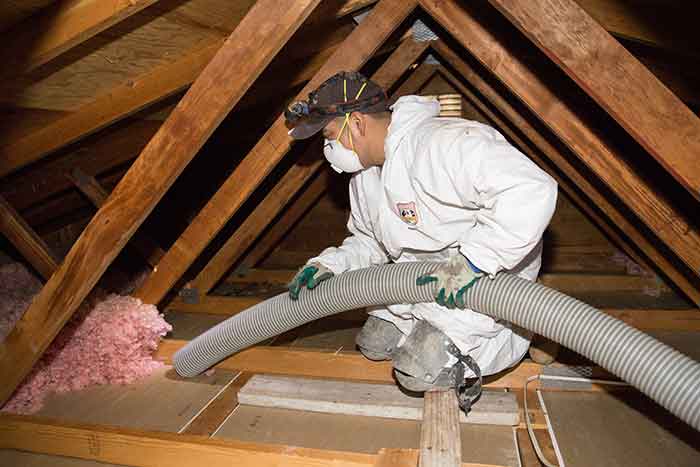If you’re looking to install new insulation in your attic, it’s important that the old insulation be removed first. This is a messy, dusty job, but it’s also an important one to do for a few reasons.
Old insulation can be a home for mold and other allergens that can impact your indoor air quality. It can also be a safety hazard if it contains asbestos. For more information, click the Perth Insulation Remover to proceed.

If your old cellulose or fiberglass insulation in the attic isn’t doing its job anymore, it’s time to get rid of it. Not only does it make your home less energy efficient by letting heat escape in the winter and cool air out in the summer, but it can also harbor mold, which can cause serious structural damage. In addition, the dust and allergens that accumulate in old insulation can be harmful to your family’s health.
Fortunately, removing old insulation isn’t an impossible task. However, you need to know how to do it safely. Before you begin, wear protective clothing and a mask to avoid inhaling the dust particles and allergens. Additionally, it’s important to cover up and secure any openings that lead into the living space. This will help prevent contaminated air from escaping the attic and traveling through other rooms of your home, where your family members can inhale it.
The preferred method for removing blown-in insulation is to use a specialized machine that uses a vacuum process to suck the material out of your attic. These machines typically have a long hose to reach from the attic to the outside and can usually be rented for an affordable rate. Before you start the process, it’s important to clear the work area of any obstacles that could interfere with the machine’s performance. Also, make sure the space is free from water and foreign objects such as wood chips or nails that may have been left behind during other construction projects.
After completing the removal process, you will need to dispose of the old insulation material in large heavy-duty garbage bags. You should find a local recycling or waste management facility that accepts fiberglass and cellulose insulation, which can then be reused in new products.
While removing old insulation is an important part of improving your home’s energy efficiency, it is not always necessary. If moisture, pests, or pollutants do not damage your existing insulation and is still in good condition, it can be a smart choice to simply add more. One option is injection foam insulation, which can be installed in your walls without the need for a full home remodel.
Insulation is designed to keep your home warm in the winter and cool in the summer. It is also an important part of your home’s energy efficiency. However, old insulation can become a risk to your health and the structural integrity of your home if it becomes moldy or is exposed to moisture. This is why removing old insulation is so important to protect your family and save on your energy bills.
Insulation that has been affected by water or rodent urine can often develop a musty smell and is very likely to have mold growth. If this is left unchecked it can compromise the integrity of the attic and cause rot or even structural failure in that area of your house. Moldy insulation can also produce airborne mold spores which can cause respiratory problems, asthma, allergies and other health issues. Removing the moldy insulation can prevent it from spreading and causing further damage to your home.
The process of removing old insulation is very messy and requires specialized equipment, a professional and the use of proper safety precautions. If you attempt to remove the insulation yourself, it is very important that you wear a mask and protective gear. Fiberglass insulation particles can be very dangerous if they come into contact with your skin and are inhaled. It is also recommended that you cover up adjacent rooms and close doors to prevent fiberglass particles from escaping into other areas of your house.
If you have blown in cellulose or fiberglass insulation, it can be very difficult to remove without a specialized vacuum machine. This is because it must be broken up into small pieces so that it can be sucked out of the attic. A specialized insulation removal vacuum is gas powered and has long hoses to reach all corners of the attic. The machine sucks the insulation into a bag which is then disposed of.
If you suspect that your attic has become the home of mice, squirrels or raccoons, it is important to have them removed before they breed and create more problems. These pests can spread disease, contaminate food and gnaw through wires creating a fire hazard. They can also leave behind their urine, feces and droppings which can contaminate your living space. Removing the insulation and re-insulating the attic can help prevent these pests from nesting in your home and protect your family.
Old insulation can be a breeding ground for mold and mildew, which negatively affect your home’s air quality. These contaminants can lead to breathing difficulties, irritated skin and eyes, asthma and more. Replacing your insulation is an affordable way to keep your family healthy.
Rodents view attics as ideal spaces to build nests, raise their babies, and stay away from predators. Infestation with rodents can be a real issue, since their droppings can permeate the entire house and give off pheromones that attract more mice and rats to the area. Old insulation can also become contaminated with their urine and feces, which is another health risk. Insulation removal professionals know how to safely and quickly remove old insulation, allowing you to get back to your normal routine with peace of mind.
Whether your old insulation is damaged, waterlogged or just outdated, it’s important to remove it as soon as possible. Putting off the task could cost you in more ways than one in terms of energy costs and the quality of your home’s air. In addition, it can negatively impact your home’s resale value and make your property unappealing to potential buyers.
Insulation removal is not a job to take lightly. It’s a time-consuming and challenging project that requires extensive safety measures. To avoid any potential accidents, you need to purchase a proper insulation removal machine like the AccuVac 14 Insulation Removal Vacuum and follow a few tips that will help make your job easier.
Before you start working, cover up any areas of the room that you don’t want to get messy. Once you’ve prepared the space, put on your protective gear and begin the process of removing the insulation. It’s important to wear a respirator because fiberglass can sting your eyes and skin. It’s also crucial to have full-body coverage, including your hands and feet.
Using an insulation remover is the safest and most effective way to eliminate your home’s old, ineffective, or unhealthy insulation. By doing this, you can keep your family healthy, reduce energy bills, and boost your home’s resale appeal.
A pest infestation can be costly, especially if you don’t catch it early on. Integrated pest management, or IPM, is a method that combines preventive steps with the use of natural and biological control methods. It reduces costs and uses pesticides as a last resort. These preventive measures include addressing attracting factors, such as open food sources, and blocking entry points.
Many pests enter homes in search of shelter during extreme weather or to take advantage of the food and water available indoors. A gnat problem can be caused by standing water in the kitchen or bathrooms, while a cockroach or fly infestation can result from rotting food or an open trash container.
Pests are also drawn to the warmth and humidity of buildings. Cracks in walls and eaves, loose siding, or a faulty roof allow them to move inside.
You can help keep pests out by identifying potential entrance points and making sure that they are caulked or filled as soon as you discover them. In addition, it is helpful to keep all windows and doors shut when not in use. A mesh screen on a window can be a simple and effective way to stop flies, mosquitoes, and other bugs from entering.
Rodents, spiders, and other pests often gain access to your home through cluttered landscaping. Make sure wood piles are kept away from the house, bushes are trimmed regularly, and yard debris is cleared. Clutter can also provide a hiding place for rodents, who may then chew through electrical wiring and other pipes to make their way inside.
It is important to inspect your establishment on a regular basis for signs of pests, such as droppings or an oily odor. If you have a pest problem, a professional exterminator can assist you in eliminating it before it becomes a serious issue.
A good insulation remover can make the job of removing fire, smoke and water damaged insulation in attics, sidewalls and crawl spaces quick and easy. An insulation removal vacuum can quickly and effectively remove wet or dry blown-in, cellulose or mineral wool insulation into disposable collection bags or directly into trash dumpsters.




 Job Duties
Job Duties
